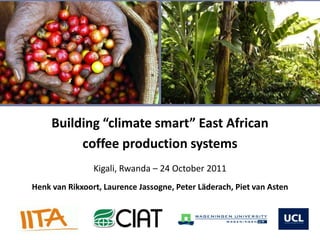van Rikxoort - Building 'climate smart' East African coffee production systems
- 1. Building ŌĆ£climate smartŌĆØ East African coffee production systems Kigali, Rwanda ŌĆō 24 October 2011 Henk van Rikxoort, Laurence Jassogne, Peter L├żderach, Piet van Asten
- 2. AGENDA ’üĮ Opportunities for East African coffee ’üĮ Challenges for East African coffee ’üĮ Classification for East African coffee ’üĮ 1 ŌĆō Yield ’üĮ 2 ŌĆō Adaptive capacity ’üĮ 3 ŌĆō Carbon footprint ’üĮ Institutional landscape ’üĮ Conclusions 2 Building ŌĆ£climate smartŌĆØ East African coffee production systems
- 3. OPPORTUNITIES FOR COFFEE ’üĮ Coffee constitutes a large proportion of both GDP and exports share in East African countries ’üĮ Coffee here is predominantly produced by smallholders ’é¦ AFDB (2010) ’é¦ ICO (2011) 3 Building ŌĆ£climate smartŌĆØ East African coffee production systems
- 4. NEED FOR ADAPTATION ’é¦ L├żderach et al. (2010) 4 Building ŌĆ£climate smartŌĆØ East African coffee production systems
- 5. NEED FOR MITIGATION ’üĮ Increasing consumer demand for products which emit fewer GHG emissions ’üĮ Retailers, the private sector and certification bodies start to address GHG emissions in coffee supply chains ’é¦ Retailers ’é¦ Certification bodies 5 Building ŌĆ£climate smartŌĆØ East African coffee production systems
- 6. CLASSIFICATION FOR EAST AFRICAN COFFEE Unshaded Unshaded monoculture monoculture Estates Coffee ŌĆō Shaded banana Smallholder farming monoculture intercrop Coffee ŌĆō tree system Coffee garden Wild coffee 6 Building ŌĆ£climate smartŌĆØ East African coffee production systems
- 7. YIELD 1: Arabica x banana 4000 Unshaded (Uganda) 2: Arabica x banana Shaded (Uganda) 3000 3: Robusta x banana Shaded (Uganda) yield (kg/ha) 2000 4: Arabica monocrop Unshaded (Kenya) 5: Arabica monocrop Unshaded (Uganda) 1000 6: Arabica monocrop Shaded (Uganda) 7: Robusta monocrop 0 Shaded (Uganda) 1 2 3 4 4 5 5 6 6 7 7 coffee system 7 Building ŌĆ£climate smartŌĆØ East African coffee production systems
- 8. ADAPTIVE CAPACITY ’é¦ Shading ’é¦ Intercropping 8 Building ŌĆ£climate smartŌĆØ East African coffee production systems
- 9. CARBON FOOTPRINT Carbon footprint per unit product 12 11 Sum = 9.2 10 Sum = 9.4 9 Pesticide production 8 kg CO2-e/kg-1 parchment coffee Sum = 3.7 Gas use 7 Sum = 3.9 Diesel use 6 Electricity use 5 Off-farm transport 4 Crop residue managment 3 Waste water production 2 Fertiliser induced N2O 1 Fertiliser production 0 C sequestration in trees -1 Trad-po Com-poly Shad-m ly ono Unshad-mono -2 -3 -4 9 Building ŌĆ£climate smartŌĆØ East African coffee production systems
- 10. INSTITUTIONAL LANDSCAPE Governments ’üĮ Need for policies that support climate smart coffee production systems Research and extension ’üĮ More research attention needed for systems rather than single crops Private sector ’üĮ Involvement of private sector needed in addressing climate change in coffee supply chains 10 Building ŌĆ£climate smartŌĆØ East African coffee production systems
- 11. CONCLUSIONS ’üĮ Global trends indicate that adapting to and mitigating climate change will be key for coffee production systems to be effective in the future ’üĮ Coffee in East Africa is produced in different systems with different characteristics and benefits ’üĮ Climate smart systems use intercropping with other food crops and shading to combine adaptation and mitigation ’üĮ Support from governments, research institutes and the private sector is needed to promote and implement these climate smart systems in the region 11 Building ŌĆ£climate smartŌĆØ East African coffee production systems
- 12. THANK YOU International Institute for Tropical Agriculture (IITA) Coffee ŌĆō Banana Intercropping Team International Center for Tropical Agriculture (CIAT) Decision and Policy Analysis Program (DAPA) Wageningen University and Research Centre (WUR) Plant Research International (PRI) Henk van Rikxoort E-mail: henk.vanrikxoort@wur.nl Laurence Jassogne E-mail: ljassogne@gmail.com 12 Building ŌĆ£climate smartŌĆØ East African coffee production systems











